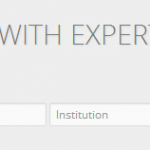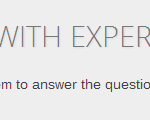Recognizing the need for increased transparency, reach and impact, today Integru.org launches Interact (beta), with a first wave of features designed around the idea of community: you can now participate directly and easily in resolving all cases of (alleged) misconduct on Integru.org!
The experts in the field who provide the reviews are still the cornerstone of the Integru platform, however most of the work for resolving a case is done elsewhere, by many independent people: searching for appropriate experts in the field and inviting them to participate are two of the most daunting tasks. Highlighting and annotating documents is another behemoth.
The idea is simple: Everyone — literally everybody — with an internet connection, from the general public to the most prestigious academic, can now easily participate and are highly encouraged to do so!
Visit the new published reviews, Review 9 and Review 10, to try the Interact (beta) features on the spot and help in obtaining more reviews and information!
So what is Interact (beta)? For now, a first wave of 3 features: Recommend, Invite, and Answer.

 Recommend experts directly
Recommend experts directly
Know someone with expertise in a case that you see online on Integru.org? Then just use the Recommend form (try it out) that you see on the review page!
Input their brief contact info as a first step. It’s Ok if you don’t know their email, but it would be nice if you made an effort to find it and include it. Otherwise the process takes longer as someone else will have to do it.
 Invite them on the spot
Invite them on the spot
You may know them, or you may be their student, or you may work in similar fields … or simply you know of them … then why not invite them to participate? After entering their contact details, you will see the Invite form (try it out), where you can choose to send an invitation to them or just submit their contact details to Integru.org.
You can edit the text of the invitation to your liking (it is after all signed off by you). You can also choose from an Informal or Formal invitation template to start you off — normally you don’t have to edit the text too much. The whole process is a matter of minutes or even less!
You are not asked to provide your email but you are asked to sign off the invitation as a matter of courtesy to the invited experts. Don’t worry about spamming the experts or anyone else. Your invitations are not sent blindly. They are first reviewed before they are emailed on your behalf. The experts who receive such an invitation can click the link to visit the case page, and provide answers on the spot … see below!
You can also choose to only send their contact details to Integru.org, but that means that someone else needs to invite them and the process takes longer. However, we appreciate that there are many of you who know of experts in the field but do not feel comfortable emailing them personally.
 Answer the review questions yourself on the spot
Answer the review questions yourself on the spot
Many of you have expertise in the field of a case. Why not answer the review questions yourself as well and join all other experts who participated on Integru.org? You can do that now directly from the review page using the Answer form (try it out). Consider yourself warmly invited!
First, provide your contact details and institution or company you are affiliated with. Then include a webpage address which shows the affiliation you have with the institution. This is for verification and to protect the Integru platform from the less well-intentioned individuals.
Then proceed and answer the review questions. Your submission will be reviewed and if everything looks Ok — and why shouldn’t it? — you will be contacted for confirmation. Once that happens, your review is published and you become the latest spearhead taking a public stance against academic misconduct, deserving all the merit!
You may also become an Integru.org Independent Collaborator!
An Integru.org Independent Collaborator?
Sounds great … but what does that mean? Many times the admins contact and invite the active contributors to become a closer collaborator. You will have an account on the website and access to Editorial features. These include inviting other experts recommended to Integru.org by others, interacting with the invited experts, helping with document preparation, the writing and publication of new cases, be involved in improving the Integru platform etc.
For instance, all invitations to experts until now were sent by such independent collaborators, signed by themselves, and now you can invite experts in the same way using the Invite form. Another example are the highlighting of documents and recommendation of experts in Review 10 and 9 and others in the past: they were done by such independent collaborators.
You can remain anonymous to us if you wish. For example, the documents in Review 10 where found, highlighted and scanned by an anonymous independent collaborator. Yes, all those 400+ pages! We have no idea who he/she is, and we don’t ask either. It’s their work which is important, which makes a difference, and which is appreciated by the community and the general public.
Integru.org is really just a platform. A peer-driven one. The general public and the academics (in other words, you) are in control and it will grow and become more open. Today’s launch is just a first step.
Engage in discussion
We have an Opinions section where anyone can contribute with a piece related to academic/education integrity and other linked issues.
First, you are warmly invited to write an Opinion. Just use the contact form or to get in touch.
Second, do engage in the discussion of the articles published. Comments are open to everyone, and you can remain anonymous if you wish. The authors of the articles are very eager to interact with the readers as many of them have not written on the subject before.
Professor Andrew Galloway, the Chair of the Department of English at Cornell University, USA, has just written an Opinion article which is also a direct invitation for a public discussion and debate, and he has expressed keen and genuine interest in learning more about the Romanian system and what could be done, from you, the readers! You can start now by sharing your thoughts on Professor Galloway’s Opinion.
Spread the word
There is a Facebook page, also a Twitter feed and of course the Integru.org website. Public comments are welcome so do participate in the discussion on Opinion articles but also one the published Reviews – you can post public comments to provide more details about a particular case or potential corrections. The comments are moderated so if you wish to provide private information, just mention that in your comment and we won’t publish it; or use the contact page.
Spread the word about the new Interact (beta) features and have your friends and colleagues participate!
What’s next?
In short … plenty! There will be dedicated web interfaces for pretty much every task that goes on during the lifetime of a Review case, from its inception to publication and afterwards, including submission of a new case, searching for experts initially, etc. These are already in the works so stay tuned!
Remember, Integru.org is just a platform. It is driven by the general public and independent academics and experts … you are part of it.
There is no central authority for academic integrity, yet education and research are international and without borders. It is thus down to us to implement an efficient mitigation system and to participate in it and maintain it open and independent, just like academia is meant to be.
This launch is just the first step.


Dear all,
I hope that integru.org is a site addressed to universal plagiarism and not just to Romanian one.
Let’s talk about more shortcomings of the evaluation system in research and research, generally not just in Romania. I have met all of these in Italy, Austria, Romania….
.Articles with ten co-authors for which worked just one or two;
.Projects in which are employed “cheap “researchers (usually from Eastern) on very low salaries and the key-researchers of the projects doing nothing else than collecting high salaries, eventually the researchers having no rights to publish;
.Researchers who are employed just on the basis of uncompetitiveness and obedientness criteria – understanding less about projects ensure uncompetitiveness later;
.Commissions according funds created on the basis of friendship, etc
.PhD students with no basic knowledge becoming the next scientists
and the list is open
Feel free to use the Contact page to submit any conclusive material that you have.
What is worse: to plagiate a dissertation or to use a fake doctor title?
Norica Carmen Godja, manager of scientific area at CEST-Wiener Neustadt, Austria, with a CV that can be found here http://www.zukunftsakademie.or.at/media/com_eventbooking/cv_dipl.-ing.%20norica-carmen%20godja.pdf is a graduated of the Faculty of Textiles – leather treatment.
She is getting EU projects in electrochemistry engineering using a FAKE doctor title.
http://cordis.europa.eu/projects/rcn/108902_en.html
Coordinator: CEST KOMPETENZZENTRUM FUR ELEKTROCHEMISCHE OBERFLACHENTECHNOLOGIE GMBHÖSTERREICH
Administrative contact: Norica-carmen GODJA (Dr)
Viktor-Kaplan-Strasse 2, WIENER NEUSTADT, ÖSTERREICH
Tel: +43-26222226618
Email: Contact
The title of this project is hilarious and wrong from scientific point of view.
Chromium free surface pre-treatments and sealing of Tartaric Sulphuric Anodizing-
Dr Norica Carmen Godja
The pre-treatments refer to a free surface of Chromium?a free surface is: the surface of a fluid that is subject to constant perpendicular normal stress and zero parallel shear stress, such as the boundary between two homogenous fluids, for example liquid water and the air in the Earth’s atmosphere. Unlike liquids, gases cannot form a free surface on their own(Wikipedia). We can not beleive that the CEST’s Chromium used is forming a free surface.
Chromium refers to a metalic state (0) but the pre-treatments refers to an electrolyte containing chromate(CrO4)2- with Cr(VI). So, it might be chromate instead of chromium. This confusion is annoying for a chemist.
Then – Tartaric Sulphuric Anodizing- which one is anodizing here? The Tartaric Sulphuric? I really can not beleive it. It might be Tartaric Sulphuric Acid (TSA) – anodizing instead of acid is another annoying error.
Sealing of Tartaric Sulphuric Anodizing – who is sealing here? The Tartaric Sulphuric Anodizing? The sealing is of the aluminium oxide pores formed during of anodization process.
Conclusion: not any undergraduated of the Faculty of Textiles could be a scientific manager in chemistry/physics and more, a doctor.
“Dr” Norica Carmen Godja uses to fire the researchers with scientific studies (doctor and professors) maybe she wants to be the only one scientist who remains at CEST.
If the scientific meaning of the title looks as this one, how would be the results of research?
Bellow there are three proposals on a similar topic, all of them looking also very similar
1. Chromium free surface pre-treatments and sealing of Tartaric Sulphuric Anodizing
Dr Norica Carmen Godja
Objective: Corrosion of Al has to be counteracted by first anodizing the Al parts and applying further protective coatings. Anodized aluminium is normally further processed with a sealing as a final step after anodizing. A hot water sealing process is one of the widely used methods. However in order to close (seal) the pores in the aluminium oxide anodized layer for corrosion protection a process involving boiling water containing chromate is still commonly used. Cr(VI)-based sealing solutions have been employed for several decades, but remain one of the most effective and commonly-used methods to improve corrosion resistance of anodized aluminium. Alternative sealing methods have also been proposed for example with Ni(II), Co(II), Ni(II) and Co(II), rare earth salts alkali metal fluorides, alkanolamine salts of phosphonic acids, Cr(III), fatty acids, silicates, etc. Kendig and Buchheit indicate that 45 of the 92 naturally occurring elements have been considered as replacements for Cr(VI) in conversion coatings on aluminium. In general these approaches have not been as successful as the Cr(VI) sealing. Also it should be noted that Ni(II), Co(II) and fluorides are not without health implications, whereas most organic molecules would be expected to have limited lifetimes under the extreme conditions (UV radiation, low pressure, large temperature range) experience by commercial aircraft during operation.
Therefore, of the previously identified approaches Cr(III)-containing or silicate-forming sealing solutions are preferred options. Encouraging results were obtained with deposition of films of CeO2.2 H2O on aluminium alloys in a few minutes at room temperature with or without catalyst, though the performances still do not equal those of CCC. Detailed investigations and characterization of the obtained will be performed. The optimized sealing and pre-treatments process will be applied to a flat test panel of 384 x 742 mm.
2. Corrosion protection of Aluminium unpainted parts: development of an appropriated Cr free sealing process on thin SAA layer (5 µm)
Dr Erich Kny
Objective: Corrosion of Al has to be counteracted by first anodizing the Al parts and applying further protective coatings. During anodizing, Al reacts with the electrolyte and a layer of aluminium oxide is formed, which is highly porous and is subject to corrosive attack. Therefore, anodized Al is normally further processed with a sealing as a final step. Sealed SAA industrial processes providing thicker layers (~10 µm) are already in the market, but the missing step is to develop a well-suited process for thin layers ( 5 µm) that meets the corrosion resistance requirements.
Hot water sealing is one of the widely used methods. However in order to close (seal) the pores in the anodized layer for corrosion protection a process involving boiling water containing chromate is still commonly used. Cr(VI)-based sealing solutions have been used for several decades, but remain one of the most effective and commonly-used methods to improve corrosion resistance of anodized Al. Alternative sealing methods have also been proposed, e.g. with Ni(II), Co(II), Ni(II) + Co(II), rare earth salts, alkali metal fluorides, alkanolamine phosphonates, Cr(III), fatty acids, silicates, etc. It should be noted that Ni(II), Co(II) and fluorides are not without health implications, whereas most organic molecules would be expected to have limited lifetimes under the extreme conditions (UV radiation, low pressure, large temperature range) experience by commercial aircraft during operation. Therefore, of the previously identified approaches Cr(III)-containing or silicate-forming sealing solutions are preferred options. Encouraging results were obtained with deposition of films of CeO2x2 H2O, though the performance still does not equal those of CCC. Characterization with methods such as SEM, EIS, AFM-SECM will lead to more detailed understanding of sealing and corrosion mechanisms and therefore optimizing sealing parameters with respect to corrosion resistance and minimized energy consumption.
3. Chromate free and energy efficient sealing of TSA anodic films for corrosion protection
Dr Erich Kny
Objective: Corrosion of Al has to be counteracted by first anodizing the Al parts and applying further protective coatings. During anodizing, aluminium reacts with the electrolyte and a layer of aluminium oxide is formed on the surface of the aluminium specimen. This coating is highly porous and is subject to attack from the environment and corrosive elements. Therefore, anodized aluminium is normally further processed with a sealing as a final step after anodizing. A hot water sealing process is one of the widely used methods. However in order to close (seal) the pores in the aluminium oxide anodized layer for corrosion protection a process involving boiling water containing chromate is still commonly used. Cr(VI)-based sealing solutions have been employed for several decades, but remain one of the most effective and commonly-used methods to improve corrosion resistance of anodized aluminium. Alternative sealing methods have also been proposed for example with Ni(II), Co(II), Ni(II) and Co(II), rare earth salts, alkali metal fluorides, alkanolamine salts of phosphonic acids, Cr(III), fatty acids, silicates, etc. Already about 45 of the 92 naturally occurring elements have been considered as replacements for Cr(VI) in conversion coatings on aluminium. In general these approaches have not been as successful as the Cr(VI) sealing. Also it should be noted that Ni(II), Co(II) and fluorides are not without health implications, whereas most organic molecules would be expected to have limited lifetimes under the extreme conditions (UV radiation, low pressure, large temperature range) experience by commercial aircraft during operation. Therefore, of the previously identified approaches Cr(III)-containing or silicate-forming sealing solutions in REACH compliant processes are preferred options. An adaption of the electrical TSA cycle for improved corrosion resistance without negative impact on fatigue life of components will be developed. Detailed investigations and characterization of the obtained corrosion protected surfaces via ESEM, Raman + IR-spectroscopy and ESCA will be performed.
Please use the Contact page to submit any conclusive documents and other material that you have. If you can highlight the offending sections/paragraphs in each document, that will help our collaborators analyzing/processing it for review.
ceva stiri de pe slahdot si nature:
http://www.nature.com/news/romanian-science-in-free-fall-1.13579
http://science.slashdot.org/story/13/08/30/179209/romanian-science-in-freefall
Norica Carmen Godja became just a “Mrs” on Cordis web pages, maybe as a result of being published on integru.org above. Note the (Mrs) used now (see below) as opposed to (Dr) used on 28 Aug (see my comment above from 1.5 months ago).
I ask how it is possible to use a fake academic title and to be still a manager of scientific area and get funded by EU research programs?
http://cordis.europa.eu/projects/rcn/110478_en.html
Coordinator: CEST KOMPETENZZENTRUM FUR ELEKTROCHEMISCHE OBERFLACHENTECHNOLOGIE GMBHÖSTERREICH
Administrative contact: Norica-carmen GODJA (Mrs)
Viktor-Kaplan-Strasse 2, WIENER NEUSTADT, ÖSTERREICH
Tel: +43-26222226618
Fax: +43-26222226650
Email: Contact